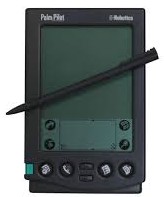What can I say that’s new about charge capture? We started as a company back before the turn of the century (I’m not sure when that is going to stop being ironic as it wasn’t that long ago, but then again, we’re almost a quarter of the way through the century, so maybe it’s longer ago than it feels like to me. . .) in 1999 to help doctors with charge capture. Not just hospitalists (who were barely a thing back then), but docs from all specialties in all practice locations. We saw the inefficiency of paper-based processes and helped guide our clients into the information age. It started out on palm pilots, progressed to web-based for use on desktops, and has now evolved to integrate into the EHR (although we still have a top-flight mobile app). So, while it’s not really brand new (we’ve been doing it for a few years now), it does feel like something that’s worth talking about more.

Remember Palm Pilots?
One of the best parts of integrating with the EHR is the time savings for the providers. No one likes to spend their time duplicating their efforts in multiple places. We eliminate a lot of the duplicate entry that goes on surrounding diagnoses. We’ve all been admonished by our respective leadership teams to keep the problem list up to date and accurate. And then we all must put appropriate diagnoses on our charges. By integrating with the EHR we can help eliminate one of those steps. By pulling the diagnoses from the problem list, we save our providers the effort of finding those diagnoses again for their charge, and we improve compliance by making the charge more accurately matched with the patient record.
In addition, facilitating charge capture at the time of the encounter leads to multiple other benefits. When you’re done with your encounter and you’re writing your note, you do your bill right then. This helps to improve accuracy (which helps prevent down coding. Down coding occurs when someone tries to do the math in their head as to how long they gave an infusion and end up rounding down to the closest even number) gets the charge out the door faster (which improves charge lag), and makes it more likely for the charge to get done at all (preventing missing charges and lost revenue).
So, if you’re doing your charge capture some way other than integration in your EHR, it might be time to think about switching. Let’s not wait until the turn of the next century. . .
Get the latest updates and news delivered to your inbox.
Subscribe to our newsletter today.





